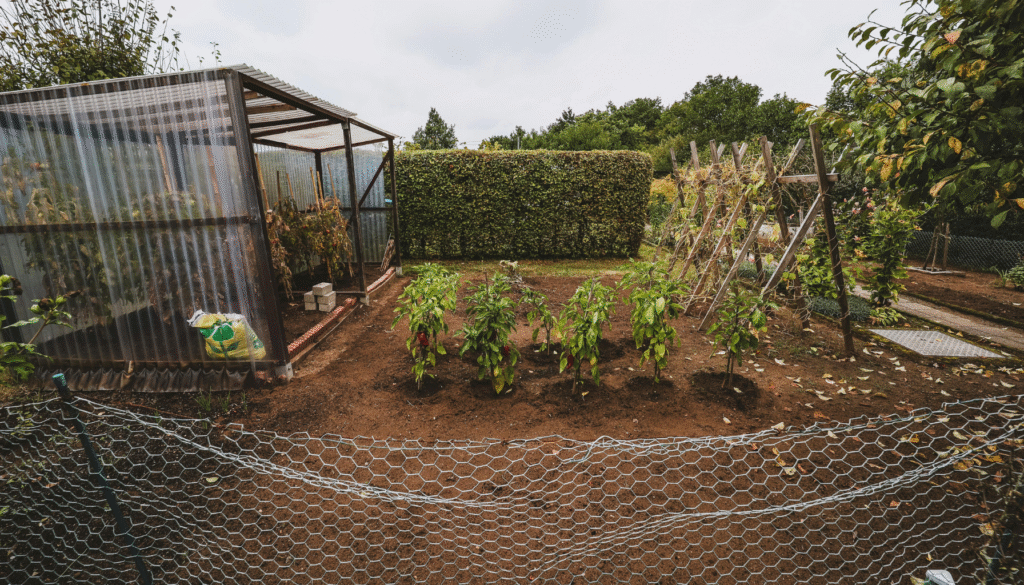Imagine harvesting fresh vegetables, collecting rainwater, or gathering eggs from your own backyard chickens. Self-sufficient living is within reach, even for beginners with small spaces. You don’t need a large plot or a rural lifestyle—just a few practical projects to grow food, conserve resources, and live more sustainably. This article shares simple, family-friendly steps to create a thriving homestead, inspired by Ron and Johanna Melchiore’s 40 years of off-grid expertise. Start small, and watch your backyard transform into a hub of self-reliance.
The Joy of Self-Sufficiency
Self-sufficient living saves money, reduces environmental impact, and brings the satisfaction of producing your own resources. Home gardening can cut grocery bills by 15-20%, while sustainable practices like composting minimize waste. Whether you’re a beginner homesteader or a seasoned gardener, self-sufficiency fosters resilience and a deeper connection to nature. Let’s explore easy projects to build a sustainable lifestyle, perfect for small spaces and busy schedules.
1. Grow a Family-Friendly Garden
A backyard garden is a fun, rewarding way to grow your own food. Even patios or tiny yards can produce abundant harvests with the right approach. Start with beginner gardening tips like these:
- Plant easy crops such as lettuce, radishes, or cherry tomatoes, which grow quickly in most climates.
- Use containers or grow bags for herbs like basil or cilantro, ideal for urban homesteading.
- Involve kids in planting seeds or watering to make family backyard gardening a shared adventure.
Gardening promotes healthy eating and teaches sustainable living skills, perfect for fostering an eco-friendly lifestyle.
2. Start Composting at Home
Composting turns kitchen scraps into nutrient-rich soil, supporting backyard soil health and reducing landfill waste. It’s an easy, budget-friendly project for sustainable composting. Try these steps:
- Set up a compost bin, tumbler, or pile in a shaded corner of your yard.
- Add fruit peels, coffee grounds, and eggshells, balanced with dry leaves or cardboard.
- Turn the pile monthly to speed up decomposition.
This home composting guide helps you create fertile soil for your garden, boosting your self-sufficient backyard.
3. Harvest Rainwater
Collecting rainwater is a practical way to conserve water and irrigate your garden. Simple rainwater collection systems reduce utility bills and support backyard water conservation. Here’s how to start:
- Place a rain barrel under a downspout to capture roof runoff.
- Use collected water to nourish plants, preserving tap water.
- Add a mesh screen to keep debris out of your barrel.
Rainwater harvesting is a sustainable water solution that enhances your homestead’s self-sufficiency.
4. Raise Backyard Chickens
Chickens provide fresh eggs and natural pest control, making them ideal for urban homesteading chickens. Even small yards can support a few hens, pending local regulations. Follow these backyard chicken keeping tips:
- Build a compact coop for 3-4 hens to supply daily eggs.
- Choose hardy breeds like Rhode Island Reds, perfect for self-sufficient egg production.
- Feed chickens with scraps like vegetable peels to reduce costs.
Raising chickens adds protein to your homestead and teaches sustainable living practices.
5. Preserve Your Garden’s Bounty
Preserving your harvest ensures year-round access to homegrown food, a key part of sustainable food storage. These food preservation for beginners techniques are easy to master:
- Freeze blanched vegetables like green beans to lock in nutrients.
- Air-dry herbs like rosemary or thyme for long-term use.
- Try simple canning, such as making pickles with a water bath canner.
Homestead canning tips like these extend your garden’s value, reducing reliance on store-bought goods.
6. Use Solar Energy Wisely
Small-scale solar projects align with off-grid energy tips, lowering costs and supporting an eco-friendly energy lifestyle. Start with affordable solar power for backyards:
- Install solar garden lights to illuminate paths without wiring.
- Use portable solar chargers for devices like phones or small appliances.
- Pair solar with LED bulbs and insulation for energy efficiency.
These sustainable energy solutions make your homestead more self-reliant and environmentally friendly.
7. Learn from Expert Resources
Expert guidance can simplify your homesteading journey. Guides like The Self-Sufficient Backyard by Ron and Johanna Melchiore draw on their 40 years of off-grid living to offer practical advice. Covering gardening, water systems, and food preservation, this self-sufficiency guide is tailored for beginners and small spaces. Such homesteading books for beginners provide clear, actionable steps to build confidence and skills.
Exploring off-grid living resources like these accelerates your path to a sustainable lifestyle.
Connect with a Community
Homesteading thrives with support. Join a homesteading community through local gardening clubs or online forums like Reddit’s r/selfsufficiency. Share seeds, swap tips, or learn from neighbors to build sustainable living networks. These backyard self-sufficiency groups foster motivation and creativity, making your journey more rewarding.
Overcome Common Obstacles
Beginner homesteading can feel challenging with limited space, time, or experience. These solutions help you overcome homesteading obstacles:
- For small yards, use vertical planters or trellises to maximize self-sufficiency for small spaces.
- If time is tight, dedicate 10 minutes daily to tasks like watering or composting.
- Start with one project, like growing herbs, to ease the learning curve.
These beginner homesteading motivation tips empower you to keep going, no matter the hurdles.
Taking the Next Step
Building a self-sufficient backyard is a journey of practical, rewarding projects. By starting a garden, composting, harvesting rainwater, raising chickens, preserving food, using solar energy, and learning from experts, you’ll create a thriving, eco-friendly home. Begin with one idea, like planting seeds or setting up a compost bin, and grow from there.
For a detailed roadmap, explore The Self-Sufficient Backyard by Ron and Johanna Melchiore. This guide shares their 40 years of off-grid expertise, offering step-by-step projects for food, water, and energy independence. Curious? Learn more here.
Conclusion
Self-sufficient living empowers you to live greener and more independently. These easy backyard projects—gardening, composting, rainwater collection, and more—make sustainable living accessible, no matter your space or skill level. Try one project today, like starting a small herb garden, and take the first step toward a self-reliant future. Here’s to a thriving, eco-friendly homestead!



